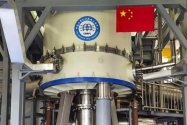
China has launched the world’s most powerful magnet for scientific research
- Facility is not much bigger than a coin but it can create a stable magnetic field of 45.22 tesla – over a million times stronger than that of the Earth
- Team at the Chinese Academy of Sciences’ High Magnetic Field Laboratory achieved their goal after making ‘major technological breakthrough’
full story -
China on Friday launched the world’s most powerful magnet for scientific research at a laboratory in the southeastern city of Hefei, in Anhui province.
The magnetic field facility is not much bigger than a coin, with a diameter of 33mm. But the Chinese Academy of Sciences’ High Magnetic Field Laboratory says it can create a stable magnetic field as strong as 45.22 tesla – or over a million times stronger than that of the Earth.
“[The Hefei facility] has become the highest steady-state magnetic field that can support scientific research in the world,” the laboratory said in a statement.
“The original world record was created by the National High Magnetic Field Laboratory in the United States in 1999. Its hybrid magnet generated 450,000 gauss [45 tesla] and it has held the record for 23 years,” it added.
Researchers at the US facility did produce a 45.5-tesla field in 2019, but the result was achieved on a test magnet that was not being used for scientific experiments.
Generating such a powerful magnetic field is challenging, partly because it requires a huge amount of energy, and the force is strong enough to lift an aircraft carrier.
Powerful magnet labs are used for cutting-edge research that could lead to game-changing discoveries. At the Hefei facility, for example, a team of physicists conducting experiments in 2016 observed a new physical phenomenon in carbon nanotubes that had potential applications in the semiconductor industry.
Their discovery and follow-up studies put China at the forefront of an international race to replace silicon with carbon in chips – a change that could lead to super fast computers that consume little power.
As a result, some Chinese laboratories are now producing the world’s largest carbon-based wafers that can be used to make sensors or chips, according to scientists involved in these projects.
Researchers have also conducted experiments involving human cells, worms and even monkeys at the Hefei magnet lab. It is believed that the stronger the magnetic field, the more likely it is that scientists can find clues through this research on everything from the ageing process and brain activity to potential cancer treatments.
Professor Kuang Guangli, lead scientist on the magnetic field project, told the Anhui News website that the team had achieved its goal of building the most powerful magnet on the planet.
The team had built a 40-tesla magnet in 2016 but were “not satisfied”, the report said. After five years of technical research to come up with the new magnet structure, develop new materials and optimise the manufacturing process they “finally made a major technological breakthrough”, Kuang said.
“Although our country’s strong magnetic field laboratory started relatively late, it only took about 10 years to make the big leap from nobody to a leader, creating the ‘China speed’ for the development of strong magnetic technology,” he was quoted as saying.
Kuang said the team would “remain low-key and humble” but they were looking forward to “a great journey”.
this is very significant breakthrough ..


